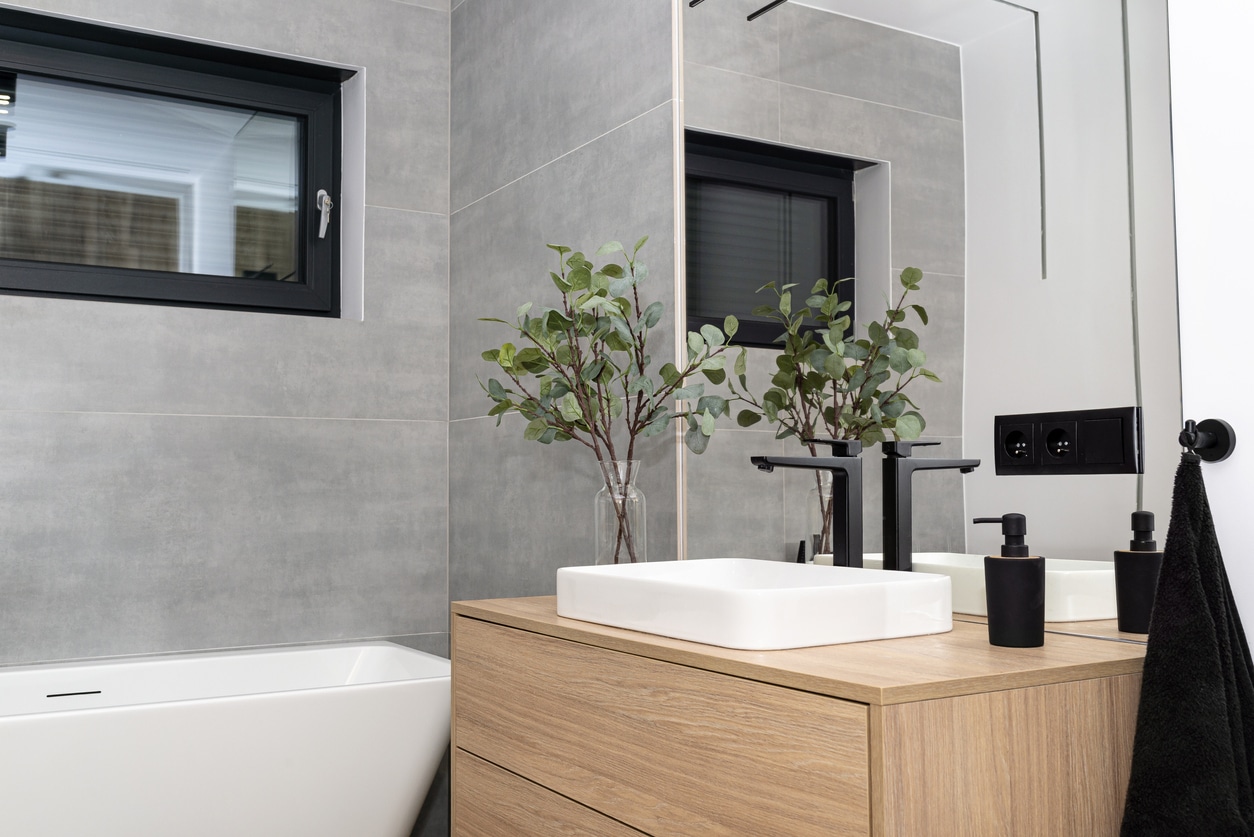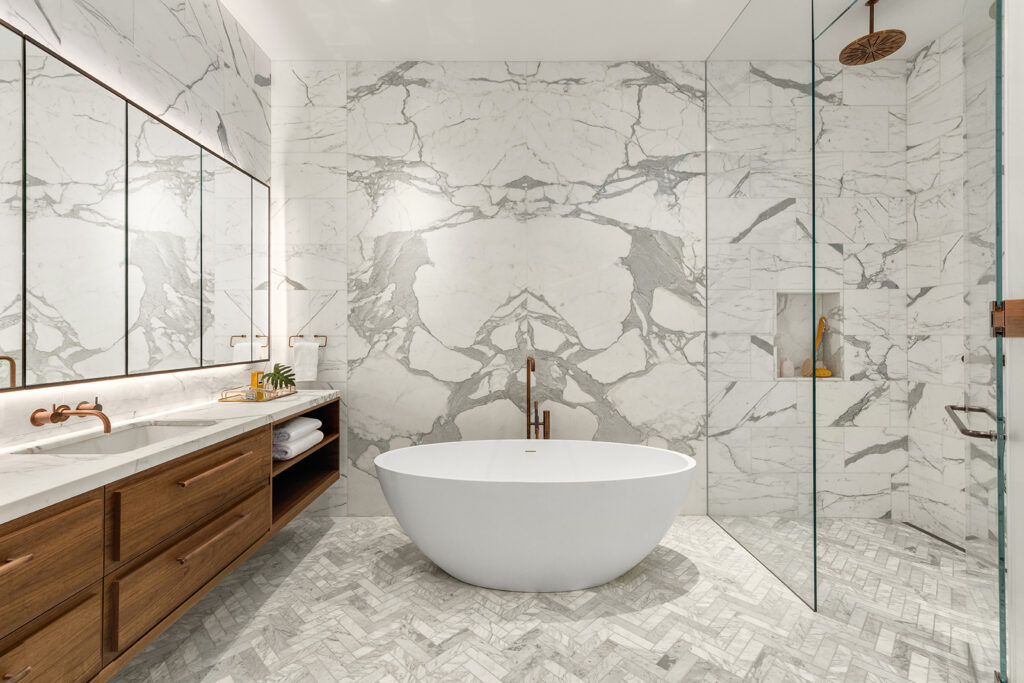
20 Best Bathroom Faucet Brands 2025
Having trouble finding the right faucet brand for your home? With this comprehensive list, we will look at the most
Looking to add more flair to your old bathroom? Well, a great place to start is replacing your old faucets and adding more color to your bathroom. Faucets make for great pairings with a new bathtub or sink, so here’s what to consider when choosing new faucets for your bathroom.
Choosing the right faucet for your bathroom sink is about more than just looks; it’s also about functionality, ease of use, and how it fits with your bathroom’s overall design. With so many types of faucets available, it’s essential to understand how each one works and what kind of sink or vanity it pairs best with. Here’s a detailed guide to the various types of bathroom sink faucets, including their design features, installation methods, and which style of bathroom they’re most suited for.
A single-handle faucet that controls both water temperature and flow, requiring only a single hole in the sink or countertop.
Best for: Sleek, modern bathrooms with a minimalist aesthetic. Ideal for smaller sinks due to its compact design.
This faucet features the spout and handles on a single base, typically in a 4-inch configuration, using three holes for installation.
Best for: Compact sinks or bathrooms where space is limited. A practical choice for traditional or contemporary designs.
Widespread faucets have separate hot and cold water handles, which are installed independently from the spout, typically requiring three holes spaced at least 6 inches apart.
Best for: Larger vanities or sink spaces, ideal for bathrooms with an elegant or more luxurious design.
Installed directly on the wall above the sink, wall-mount faucets free up countertop space and offer a sleek, modern appearance.
Best for: Vessel sinks or minimalist bathrooms where countertop space is a priority.
Vessel faucets are taller and designed to pair with vessel sinks that sit above the countertop.
Best for: Bathrooms with vessel sinks, often used in modern or high-end designs where the sink serves as a statement piece.
Featuring two handles and a spout connected by a visible “bridge,” this design offers a traditional, vintage look.
Best for: Traditional or vintage bathroom designs, typically installed in larger vanities.
Freestanding faucets are installed directly into the floor, most commonly paired with freestanding tubs but also available for sinks. These tall faucets make a dramatic design statement.
Best for: Large, open bathrooms where the sink or tub is a focal point, especially in contemporary or spa-inspired spaces.
Using motion sensors for hands-free operation, touchless faucets are highly hygienic and may be battery-operated or wired into the home’s electrical system.
Best for: Modern bathrooms focused on convenience and hygiene, also popular in commercial settings.
By understanding the types of faucets available, you can select one that best fits your bathroom’s style, layout, and functional needs. Whether you prioritize space-saving designs or luxurious aesthetics, there’s a faucet option to match every type of sink and bathroom décor.
All faucets control a bit differently from each other and there are quite a few options to ensure that the water flows the way you desire. Below are the different faucet control options available.
Knobs are one of the most common faucet control options available. One knob controls hot water, while another controls the flow of cold water. They can be turned on simultaneously to create warm water. essentially two knobs
Cross handles function very similar to knobs, with handles that are turned on and off to control hot and cold water instead of knobs. Similar to the knob control scheme, cross handles
Joysticks are handles that simply pull or flip up. Unlike the knobs and cross handles, all the control is placed on this single lever on the faucet. You turn it to one direction to change from hot to cold and simply pull down or pull back up to shut the water on and off.
For the more modern user, there are touchless models that do not require physical knobs and handles to be turned. Touch-activated sinks are available in many corporate businesses, and can simply be activated by touching the top of the faucet. A handle controls the temperature and is perfect for those with accessibility issues.
ReviewDifferent
Materials play an important role in determining both the physical qualities of your faucets as well as the look of your faucet. When choosing the right material, it is important to balance the look with the physical attributes you want in your faucet.
An iron based alloy that is resistant to corrosion, has decent temperature resistance and is quite durable. Stainless steel finishes are resistant to scratches and very suitable for daily bathroom use. It is also easy to clean with just water and soap. However, despite it’s durability, stainless steel is remarkably easy to scratch, so it is best to avoid harsh cleaners when cleaning. It also tends to be on the expensive end compared to other faucet finishes.
An alloy consisting primarily of copper, bronze sinks tend to be quite durable, scratch resistant and easy to clean. Bronze faucets are also quite easy to match as many bronze accessories are available, ensuring that their color tone can match almost any sink material.
Another quite durable sink material, brass is composed of copper and zinc, forming into a brass finish. While it shares similarities to bronze, brass tends to have a generally dull finish. Summarily, the material also takes to fingerprint and watermark stains fairly easily, so continual upkeep is recommended.
One of the cheaper options when choosing a sink material. Zinc faucets are composed of either zinc or a composite alloy that tends to not be very durable. Although these faucets tend to be quite affordable, their longevity is no more than a couple of years at the most.
The least durable material on the market is plastic. Although it may not be visually appealing, there are quite a few color options available for plastic since it is so cheap. Plastic faucets also do not contain lead, though as stated before, plastic is perhaps the least durable material, lasting a year or two at the most with heavy use.
| Faucet Type | Standard Faucet Width | Hole Requirements | Best Sink Type |
|---|---|---|---|
| Single-Hole Faucet | 4-6 inches | 1 hole | Small or modern sinks |
| Centerset Faucet | 4 inches | 3 holes (4″ apart) | Compact sinks, small vanities |
| Widespread Faucet | 6-16 inches | 3 holes (6″-16″ apart) | Larger sinks, spacious vanities |
| Wall-Mount Faucet | Varies | No countertop holes | Vessel sinks, minimalist designs |
| Vessel Faucet | 6-12 inches | 1 hole | Vessel sinks (above-counter sinks) |
| Bridge Faucet | 8-16 inches | 2-3 holes | Vintage or traditional designs |
| Freestanding Faucet | 36-48 inches (height) | Installed in floor | Freestanding tubs, large open spaces |
| Touchless Faucet | 4-6 inches | 1 hole (sensor-operated) | Modern or commercial sinks |
As stated previously, size is an important factor in choosing the right faucet. Small sizes are appropriate for smaller sinks/bathrooms while larger sizes are generally the common choice for those with medium to large sized bathrooms. The benefit of having a small faucet is that your sink can be as small and as minimalistic as you want it to be. The downside of this is of course that your sink is pretty small and will have limited functionality. A large faucet/sink on the other hand, has much more functionality allowing for separate hot and cold water taps. It is because of this that larger sized faucets are typically more common as they are generally not too much larger than smaller faucets and the added functionality benefits everyone in your home.
| Sink Type | Standard Width | Standard Depth | Best For |
|---|---|---|---|
| Pedestal Sink | 18-24 inches | 16-20 inches | Small bathrooms, compact spaces |
| Undermount Sink | 16-24 inches | 12-20 inches | Modern bathrooms, larger vanities |
| Vessel Sink | 16-20 inches (diameter) | 5-8 inches | Contemporary designs, above-counter installations |
| Wall-Mount Sink | 16-20 inches | 12-18 inches | Small bathrooms, minimal space |
| Console Sink | 24-36 inches | 16-20 inches | Spacious bathrooms, luxury designs |
| Drop-In Sink | 18-24 inches | 16-20 inches | Versatile designs, easy installation |
| Integral Sink | 18-24 inches | 16-20 inches | Modern designs, seamless look |
| Corner Sink | 12-18 inches | 12-18 inches | Small bathrooms, corner installations |
Installation can be a troublesome point for those that are inexperienced with installing a new faucet or sink. Different faucets require different plumbing knowledge to install. A bridge or single hole faucet is a bit different than a freestanding faucet. In general, faucet installation is a fairly straightforward process compared to installing a sink. So long as you understand your plumbing situation, than you can easily install a new faucet or sink. However, some homes require rerouting water lines, in which case it is best to consult a plumber.
Installing a new bathroom faucet is a relatively straightforward task that can instantly upgrade your sink’s look and functionality. Follow these six steps to get your new faucet installed properly:
Before you begin, locate the shutoff valves under the sink and turn them off by twisting the knobs clockwise. If your sink doesn’t have shutoff valves, you’ll need to turn off the water at the main supply. Open the faucet to release any remaining water pressure and ensure the pipes are empty.
Tip: Place a small bucket or towel underneath to catch any drips.
Disconnect the water supply lines from the faucet using an adjustable wrench. Once the lines are disconnected, locate the mounting nuts underneath the sink that hold the faucet in place. Use a basin wrench or a socket wrench to loosen and remove the nuts. Gently lift the old faucet out from the sink.
Tip: If the faucet doesn’t come out easily, it might be stuck due to old caulking. Gently pry it loose using a putty knife.
Once the old faucet is removed, clean the area around the sink where the faucet was mounted. Remove any old caulking, grime, or mineral buildup using a non-abrasive cleaner or a vinegar solution. This ensures a smooth surface for your new faucet installation.
Tip: Wipe the area dry before proceeding to the next step to ensure a clean, dry surface for the new faucet.
Place the new faucet into the mounting holes on the sink. Most faucets will come with a gasket or rubber ring that needs to be positioned underneath the faucet base to prevent leaks. Once the faucet is seated properly, go under the sink and hand-tighten the mounting nuts. Secure them with a basin wrench, but be careful not to overtighten, as this can damage the faucet or sink.
Tip: Make sure the faucet is properly aligned on the sink before tightening the mounting nuts fully.
Attach the water supply lines to the faucet’s hot and cold connections (they should be labeled) and tighten them with an adjustable wrench. Ensure that the connections are secure, but again, don’t overtighten to avoid damaging the fittings.
Tip: Use plumber’s tape (Teflon tape) on the threads of the water supply connections to ensure a watertight seal.
Turn the water supply back on by opening the shutoff valves under the sink. Slowly open the faucet and let the water run for a few minutes to check for leaks around the connections or faucet base. If you see any leaks, tighten the connections slightly. If there are no leaks, your faucet is installed and ready to use.
Tip: If the faucet includes an aerator, remove it before running the water, then replace it afterward to prevent debris from clogging it.
Perhaps the most important point to consider is the price of a new faucet. A new faucet can cost anywhere between $20 to $250 and beyond, depending on its features, materials, and brand.
These days, there are a multitude of different attachments and add-ons you can install to improve your faucet, but always remember to stay within budget. While many of these add-ons are trendy and visually appealing, they usually double or triple the initial cost of the faucet in the long term and may not offer real value. Focus on the material and finish of your faucet and whether the style is appropriate for your bathroom. If an add-on doesn’t enhance durability or functionality, it may not be worth the extra cost.
When choosing a new faucet for your home, always consider your budget and your needs. Although it may seem tempting to splurge on additional features, a straightforward faucet that efficiently runs hot and cold water is generally all you need. Select a style that complements your home and budget, and you’ll find the right faucet that strikes the perfect balance between form and function.
When choosing a new faucet for your home, always consider your budget and your needs. Although it may seem pertinent to splurge on some of the amenities and additions out there, a straightforward faucet that runs hot and cold water is generally what you need. So pick a style that suits your home and find the right faucet for you.

Eric is the founder and president of Badeloft USA. He has been the president of Badeloft’s US division for over ten years and oversees all marketing and branding aspects of Badeloftusa.com.
His expertise lies in small business development, sales, and home and bathroom industry trends and information.
Contact us with any business related inquiries.

Free material samples and tub templates

Having trouble finding the right faucet brand for your home? With this comprehensive list, we will look at the most

Reglazing is an excellent way of restoring your old bathtub and making it appear like new. A professional reglaze lasts

So, you’re shopping for a new bathtub and you’ve done your measurements-mapped out the space for installation, but something that

In home design, bathroom privacy often gets overlooked in favor of more glamorous elements like tile choices or statement tubs.
Fill out the form below to request a free material sample
"*" indicates required fields
"*" indicates required fields
"*" indicates required fields

Notifications